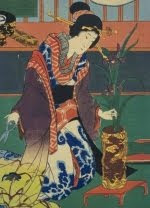Sofu Teshigahara, founder of the Sogetsu School of ikebana, was in many ways an important pioneer and a contributor to modern ikebana. In an earlier blog post discussing Sofu and Land Art, I argued that although Sofu doesn't seem to have been very occupied with Land Art, he opens up the ikebana tradition. In that sense he lays a ground for later ikebana artists to explore the site specific nature of ikebana in relation to outdoor surroundings. Have a look at the post Sofu - The Humble Beginning of Land Art Ikebana, part 1 if you're interested in Sofu's thinking on the importance of using local materials. You'll also find a couple of examples of site specific driftwood sculptures.
In this post, part 2, I'll discuss Sofu's distinction between ikebana and sculptures. I will also give a few examples of wooden sculptures placed in an outdoor environment. Thinking of Land Art, I guess most people would first think of works that are made on location, from the materials found on that location. The precise term for this would be site-specific art or sculpture. For the sculptures presented here it would be more correct to use outdoor sculpture. Or they could be site spesific sculptures produced elsewhere and moved to the site. It could also be that they are simply placed in the outdoors to make a nice photo. On the other hand this act of placing them gives them an interesting new relation to the surroundings.
In this post, part 2, I'll discuss Sofu's distinction between ikebana and sculptures. I will also give a few examples of wooden sculptures placed in an outdoor environment. Thinking of Land Art, I guess most people would first think of works that are made on location, from the materials found on that location. The precise term for this would be site-specific art or sculpture. For the sculptures presented here it would be more correct to use outdoor sculpture. Or they could be site spesific sculptures produced elsewhere and moved to the site. It could also be that they are simply placed in the outdoors to make a nice photo. On the other hand this act of placing them gives them an interesting new relation to the surroundings.
Sofu is well known for introducing sculptural ikebana, using all kinds of materials and sometimes very few or even no flowers. His avant-garde scrap metal ikebana from the 1950s are good examples of this. From the late 1950s he also exhibited as a sculptor, with his first exhibition being held at the Bridgestone Museum, Tokyo, 1957. His sculptures were carved from stone or wood, sometimes covered with beaten metal, or embedded with pieces of coloured mosaic. With forms already partly modeled by nature they are closely related to Sofu's ikebana works and the practice of using branches of trees and driftwood in the flower arrangements.
In a photo book from 1966 Sofu choses his best works of ikebana and sculptures. Surprisingly, his famous 1950s avant-garde ikebana with scrap metal are not represented. Instead he introduces a few newly made wooden sculptures. The sculptures and the ikebana arrangements are presented in the same categories, with the title being the only distinction defining some of the works as sculptures and some as ikebana. It is of course easy to see that the sculptures are the ones without flowers. But in Sofu's own texts on ikebana this distinction is not valid:
Quotations by Sofu can be found in the book:
Sofu: His Boundless World of Flowers and Form
By Sofu Teshigahara with photographs by Ken Domon
Published by Kodansha International, Tokyo / Palo Alto, California 1966
Photos are from the catalogue:
Works of Sofu, Hiroshi and Kasumi
Published by Sogetsu (undated)
In a photo book from 1966 Sofu choses his best works of ikebana and sculptures. Surprisingly, his famous 1950s avant-garde ikebana with scrap metal are not represented. Instead he introduces a few newly made wooden sculptures. The sculptures and the ikebana arrangements are presented in the same categories, with the title being the only distinction defining some of the works as sculptures and some as ikebana. It is of course easy to see that the sculptures are the ones without flowers. But in Sofu's own texts on ikebana this distinction is not valid:
"To me ikebana is principally a question of producing a desired beautiful shape, to which end one uses flowers, even dead ones. I do not believe however, that flowers are the only material with which such a shape can be produced, and I have therefore used other materials from time to time."The use of other materials to produce a shape refers to the sculptures that appears in this book. Every ikebana is a sculpture but not all of his sculptures are ikebana:
"I regard myself as a creator of shape who uses mainly flowers as his metier, rather than purely as an arranger of flowers."Another distinction could be that the sculptures are more permanent than the flower arrangements. On a philosophical level it still remains unclear where the line between ikebana and sculpture goes. An interesting observation pointed out by others is how this is influenced by Sofu's appreciation for zen-buddhistic thinking and the "conviction that all things, the ephemeral, like ikebana and the lasting, like sculpture, are at their very roots the same." There is no such thing as a permanent work of art, eventually everything changes and perishes - this is again a point made by Land Art artists and shows the relation between Land Art thinking and Ikebana philosophy.
Quotations by Sofu can be found in the book:
Sofu: His Boundless World of Flowers and Form
By Sofu Teshigahara with photographs by Ken Domon
Published by Kodansha International, Tokyo / Palo Alto, California 1966
Photos are from the catalogue:
Works of Sofu, Hiroshi and Kasumi
Published by Sogetsu (undated)
















No comments:
Post a Comment